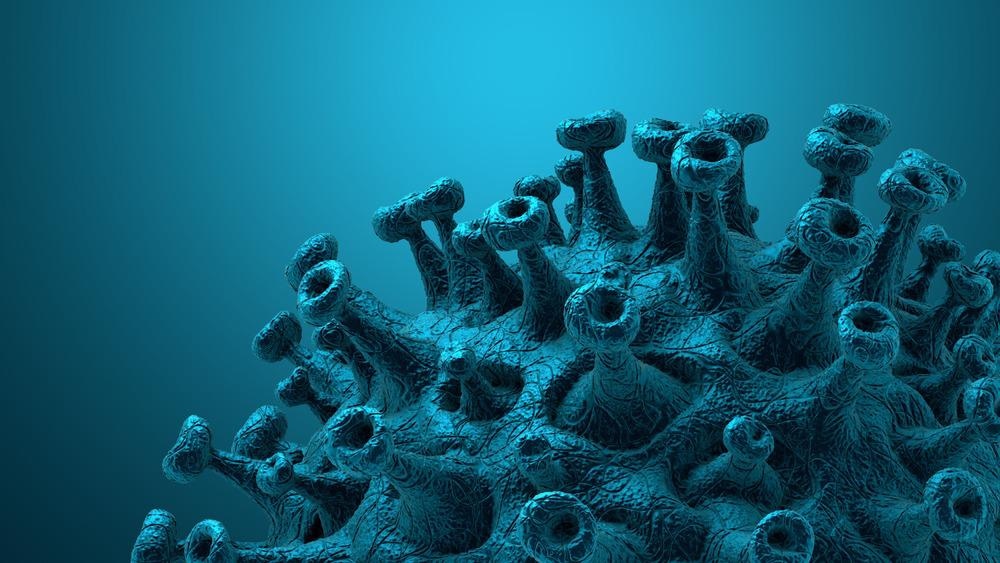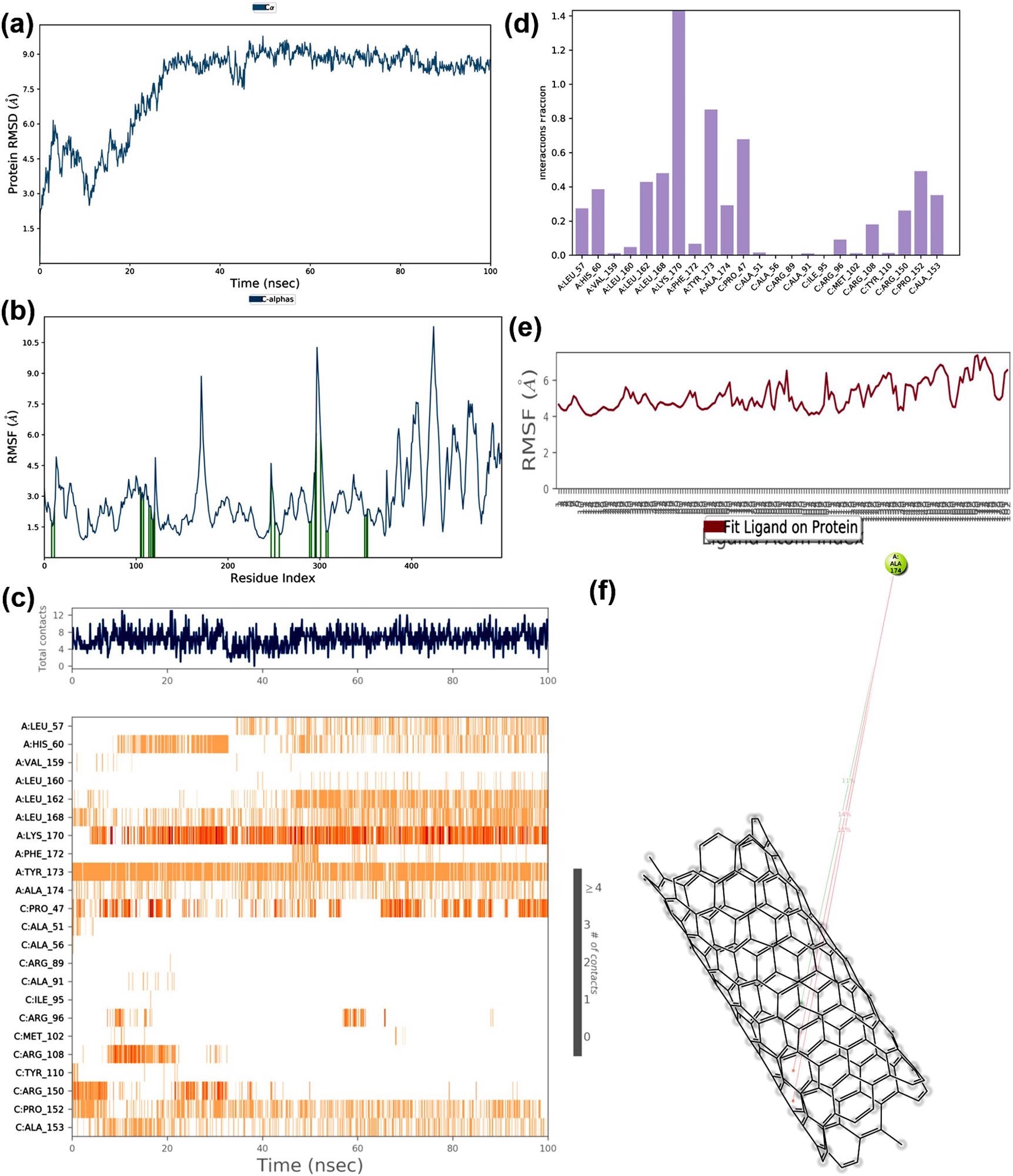A study recently published in the journal Infection, Genetics and Evolution explored the attachment affinity of carbon nanotubes (CNTs) and carbon nano-fullerene towards numerous molecular targets of severe acute respiratory syndrome coronavirus 2 (SARS-CoV-2).

Study: Carbon fullerene and nanotube are probable binders to multiple targets of SARS-CoV-2: Insights from computational modeling and molecular dynamic simulation studies. Image Credit: CROCOTHERY/Shutterstock.com
Computational modeling of the 3D architectures of nano-fullerenes and CNTs was carried out, and molecule binding and molecular dynamic (MD) simulations were used to estimate the attachment affinity of the nanoparticles to the chosen target molecules. The research emphasizes the need of using carbon nanoparticles as a treatment for COVID-19.

The potential drug targets of SARS-CoV-2 selected in the present study (a) Spike glycoprotein, (b) RNA directed RNA polymerase, (c), Main protease, (d) Papain-like protease and (e) RNA binding domain of Nucleocapsid protein. Image Credit: Skariyachan, S. et al
COVID-19 Taking the World by Storm
The shocking COVID-19 epidemic attributed to Severe Acute Respiratory Syndrome Coronavirus-2 (SARS-CoV-2), first detected in Wuhan, China, in December of 2019, has since expanded globally. A virulent pathogen, SARS-CoV-2 belongs to the ß-coronavirus family and is a positive-stranded RNA virus. The spike glycoproteins that appear on the envelope give these pathogens a crown-like appearance. Other proteins in the viral structure include membrane and envelope proteins, nucleocapsid protein, and RNA dependent on RNA polymerase as structural proteins.
Inadequacy of Current Treatments
At first, anti-viral medications including remdesivir, lopinavir, chloroquine, and hydroxychloroquine were recommended for COVID-19 infection therapy. Recent assessments, however, proved the ineffectiveness of chloroquine and hydroxychloroquine when combatting SARS-CoV-2. Several drugs are in the early phases of clinical development.
Novel variants of the virus have been discovered in various regions across the globe, with these mutations exhibiting enhanced transmission and pathogenicity, as well as reduced neutralization.
Vaccines are now available to treat COVID-19, although they have not yet reached populations in some countries. The variety of symptoms found in the patients, as well as asymptomatic transmission and vaccination resistance data, indicate that the creation of an alternative treatment answer is imminently needed.

The binding potential of carbon nanofullerene towards the prioritized targets of SARS-CoV-2 is predicted by molecular docking. The binding affinity and interactions of carbon nano fullerene towards (a) spike glycoprotein (−13.7 kcal/mol), (b) RNA dependent RNA polymerase (−12.9 kcal/mol), (c) main protease (−11.4 kcal/mol), (d) papain-like protease (−10.6 kcal/mol) and (d) RNA binding domain of nucleocapsid protein (−10.1 kcal/mol). Image Credit: Skariyachan, S. et al
Nanotechnology and Computational Biology
Modern developments in nanotechnology have revealed the possibility of using nanoparticles such as CNTs and nano-fullerenes to target various areas of SARS-CoV-2, blocking its pathogenic effects. Carbon nanotubes are being touted as potential therapeutic materials owing to excellent mechanical capabilities, structural soundness, and tunability of functional groups.
Nanomaterials may be used to create nano-based COVID-19 protective devices and disinfectants. Furthermore, nanoparticles could be employed to function as antigen carriers or serve as an adjuvant medication for use concurrently with the upcoming COVID-19 vaccines.
The team used computation-based virtual screening and MD simulations to determine the binding capability of carbon nanotubes and nano-fullerenes to numerous putative target areas of the virus. Carbon nano-fullerenes have a potential affinity for SARS-CoV-2 targets, and carbon nanotubes have demonstrated possible interactions that might limit the virus's harmful mechanism.
Identifying Structural Properties of Recognized Targets
Spike glycoproteins are the principal target of antibodies and are important in stimulating entrance into cells through the transmembrane spike. The transmembrane spike is composed of two functional subunits that are in charge of attaching to receptors of host cells and fusing the membranes of the virus and cells.
Each virus may identify distinct places of attachment and entrance by connecting with specific areas of the receptors in the host cell unit, depending on the type of viral strain. The major constituent of the viral machinery is responsible for replication and transcription; the RNA-dependent RNA polymerase (RdRp) is required for the survival of these viruses. Treatments targeting this area would be an excellent strategy.
The primary protease is an enzyme that is also involved in viral replication and transcription. The major protease is required for the digestion of viral RNA-translated polyproteins. Inhibiting this enzyme may aid in the prevention of viral replication. As a result, these proteins were chosen in the study because they might be potential therapeutic targets for SARS-CoV-2 infection.

The MD simulation trajectories of RNA binding domain of the nucleocapsid protein and nano tube complex (a) RMSD: Protein RMSD (Å) on the y-axis and time on the x-axis (b) Protein RMSF (Å) on the y-axis and residues on the x-axis (c) Protein-ligand contacts over the simulation course, (d) histogram representing interaction fraction on the y-axis and residues on the x-axis (e) Ligand RMSF (Å) on the y-axis and atoms on the x-axis and (f) Major interactions that occur during MD simulation. Image Credit: Skariyachan, S. et al
Conclusions
It may initially seem unimpressive that the targets adopt this orientation only after adsorption on hydrophobic surfaces. However, there is potential for various orientations concerning the adsorption process on hydrophobic or charged areas. Therefore, understanding the interaction modeling of many orientations is critical.
The present research lays the groundwork for future laboratory tests and exploratory trials. Despite the nanoparticles' apparent toxic nature, they might be employed as possible leads for blocking the coronavirus target areas. Research has shown the success of their use in target-specified treatments, drug transportation processes, cancer-related therapies, and other applications.
The MD simulation tests indicated that the priority entities and nanoparticles undergo dynamic interactions, which are steady and promising. When compared to carbon-fullerenes, nanotubes have the higher binding energy of the two carbon nanoparticles.
Continue reading: Nanotechnology and the Fight Against COVID-19.
Reference
Skariyachan, S., Gopal, D., Deshpande, D., Joshi, A., Uttarkar, A., & Niranjan, V. (2021) Carbon fullerene and nanotube are probable binders to multiple targets of SARS-CoV-2: Insights from computational modeling and molecular dynamic simulation studies. Infection, Genetics and Evolution. Available at: https://www.sciencedirect.com/science/article/pii/S156713482100455X?via%3Dihub
Disclaimer: The views expressed here are those of the author expressed in their private capacity and do not necessarily represent the views of AZoM.com Limited T/A AZoNetwork the owner and operator of this website. This disclaimer forms part of the Terms and conditions of use of this website.